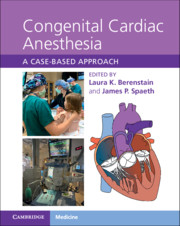Book contents
- Congenital Cardiac Anesthesia
- Congenital Cardiac Anesthesia
- Copyright page
- Dedication
- Contents
- Contributors
- Introduction
- Chapter 1 A Congenital Heart Disease Primer
- Section 1 Left-to-Right Shunts
- Section 2 Right-Sided Obstructive Lesions
- Section 3 Left-Sided Obstructive Lesions
- Chapter 14 Critical Aortic Stenosis
- Chapter 15 Aortic Stenosis
- Chapter 16 Subvalvular Aortic Stenosis
- Chapter 17 Supravalvular Aortic Stenosis
- Chapter 18 Hypertrophic Cardiomyopathy
- Chapter 19 Coarctation of the Aorta
- Chapter 20 Shone Complex
- Section 4 Complex Mixing Lesions
- Section 5 Single-Ventricle Physiology
- Section 6 Heart Failure, Mechanical Circulatory Support, and Transplantation
- Section 7 Miscellaneous Lesions and Syndromes
- Index
- References
Chapter 20 - Shone Complex
from Section 3 - Left-Sided Obstructive Lesions
Published online by Cambridge University Press: 09 September 2021
- Congenital Cardiac Anesthesia
- Congenital Cardiac Anesthesia
- Copyright page
- Dedication
- Contents
- Contributors
- Introduction
- Chapter 1 A Congenital Heart Disease Primer
- Section 1 Left-to-Right Shunts
- Section 2 Right-Sided Obstructive Lesions
- Section 3 Left-Sided Obstructive Lesions
- Chapter 14 Critical Aortic Stenosis
- Chapter 15 Aortic Stenosis
- Chapter 16 Subvalvular Aortic Stenosis
- Chapter 17 Supravalvular Aortic Stenosis
- Chapter 18 Hypertrophic Cardiomyopathy
- Chapter 19 Coarctation of the Aorta
- Chapter 20 Shone Complex
- Section 4 Complex Mixing Lesions
- Section 5 Single-Ventricle Physiology
- Section 6 Heart Failure, Mechanical Circulatory Support, and Transplantation
- Section 7 Miscellaneous Lesions and Syndromes
- Index
- References
Summary
Shone’s complex is a group of left-sided, typically obstructive, lesions of the heart, also referred to as Shone’s syndrome, disorder, or anomaly. Shone’s complex was first described in 1963 as four left-sided heart lesions consisting of a supravalvular ring of the left atrium, a “parachute” mitral valve, muscular or membranous subaortic stenosis, and a coarctation of the aorta. These anomalies cause a progressive limitation of inflow into the left ventricle and outflow obstruction from the left ventricle and aorta. There is also an association with a smaller left ventricular size and decreased left ventricular function. Lesions may progressively worsen over time, causing significant heart failure symptoms, pulmonary hypertension, and arrhythmias. Surgical intervention may range from a single intervention such as aortic arch repair to a combination of multiple procedures such as repair of aortic coarctation along with mitral valve repair and aortic valvotomy. This chapter details the perioperative management of a child with multilevel left-sided obstructive lesions presenting for noncardiac surgery.
Keywords
- Type
- Chapter
- Information
- Congenital Cardiac AnesthesiaA Case-based Approach, pp. 129 - 136Publisher: Cambridge University PressPrint publication year: 2021



